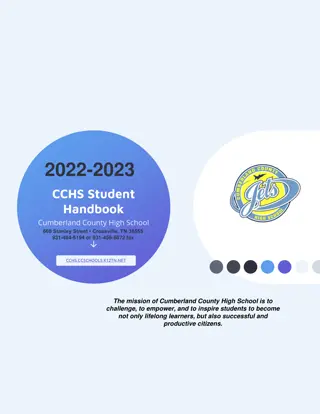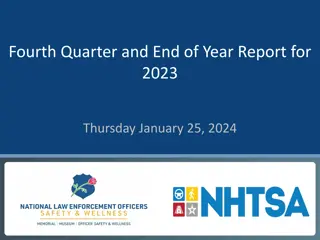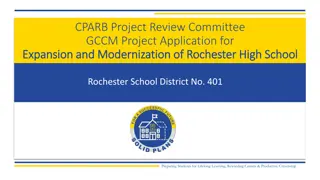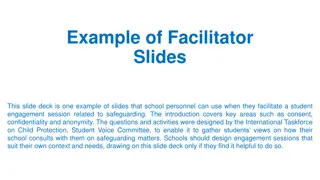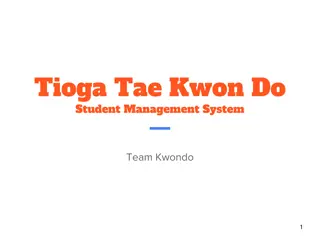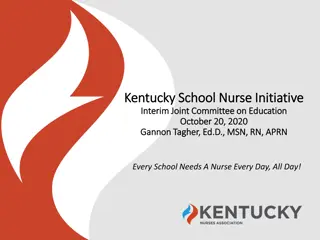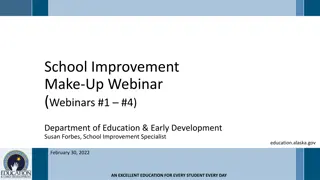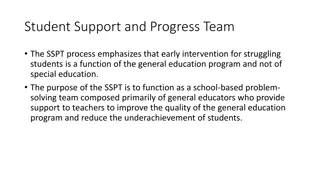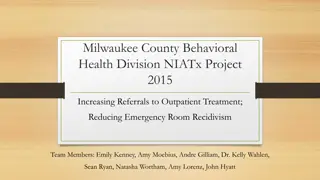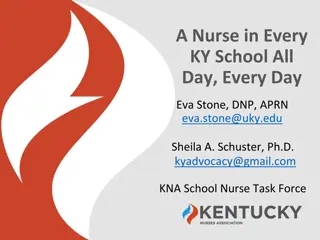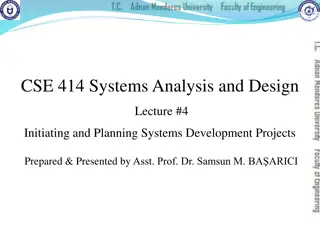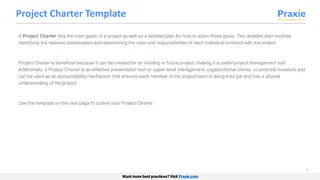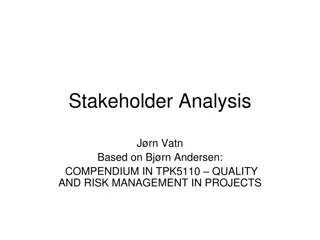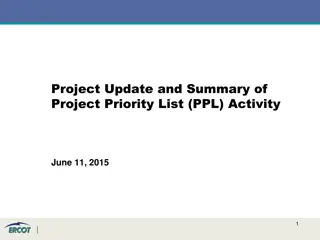Improving Seatbelt Use at Ypsilanti High School - Student Project
Regional Alliance for Healthy Schools (RAHS) and the Youth Advisory Council (YAC) initiated efforts to promote seatbelt use among Ypsilanti High School students. The project aims to address the high rate of unintentional deaths among teenagers due to motor vehicle crashes. Research shows the significant impact of seatbelt use in reducing injuries and fatalities. Peer health education is proposed as an effective approach to educate students about the importance of wearing seatbelts consistently. The project sets ambitious goals to ensure 100% seatbelt compliance among Ypsilanti High School students.
Download Presentation

Please find below an Image/Link to download the presentation.
The content on the website is provided AS IS for your information and personal use only. It may not be sold, licensed, or shared on other websites without obtaining consent from the author. Download presentation by click this link. If you encounter any issues during the download, it is possible that the publisher has removed the file from their server.
E N D
Presentation Transcript
Improving Seatbelt Use at Ypsilanti High School University of Michigan (Student Project) 1
Background: Regional Alliance for Healthy Schools (RAHS)- clinic opened at Ypsilanti High School Jan 2011 Youth Advisory Council (YAC)- group started in October 2011 http://t1.gstatic.com/images?q=tbn:ANd9GcQG93Lp-tGXLAV-PRPSyrsbHJCGhHOatdFykot22Grg_mK9mDsoSxcZsDwtFg 2
http://t2.gstatic.com/images?q=tbn:ANd9GcRpdOxHf29A6wni54egVdaE9n5d9MysoG9ljfubltwVt4DEeMJbc99mgghttp://t2.gstatic.com/images?q=tbn:ANd9GcRpdOxHf29A6wni54egVdaE9n5d9MysoG9ljfubltwVt4DEeMJbc99mgg Introduction: Identification of the Community- The median age in the city of Ypsilanti is 23.6 years; 47% are male and 53% are female. The majority of the population is White (61.4%) or African American (31%) Ypsilanti High School Students (YHS) range in age from 14-18 & majority of YHS students are racial minorities (81.9% non-Caucasian). http://t3.gstatic.com/images?q=tbn:ANd9GcRqFdNGdLhDrfn_PkYfJBC64R3SK_bALNH2kb9aDbQKYUmfY6RRinrJiZrX 3
Introduction: Unintentional deaths are among the largest causes of injuries and death among children ages 14 to 18 from 1999-2009 accounting for: State: 54% National : 55% Healthy People 2020- Reduce motor vehicle crash-related deaths Increase the use of safety belts See full size image http://t1.gstatic.com/images?q=tbn:ANd9GcSmHFObd9rTSBHxlEdrHbDT2FDO3JjEiDUAAQSMsQScPRslct-tfYvpbw http://t1.gstatic.com/images?q=tbn:ANd9GcRsLbxDuGMdwLHfULz960qbkQhbATH1fNfxurFbMIlY3Ue_VTVNbjtPg_k 4
http://t1.gstatic.com/images?q=tbn:ANd9GcSU1Vdj_LbQMwQpqefnKY0x87ayD4OhUsF5ESQYQePedbEZ2-ImmeQpaDpthttp://t1.gstatic.com/images?q=tbn:ANd9GcSU1Vdj_LbQMwQpqefnKY0x87ayD4OhUsF5ESQYQePedbEZ2-ImmeQpaDpt Review of the Literature: (Research has found) when seat belts are used they reduce the risk of fatal injury to the front seat passenger by 45% (percent) and the risk of moderate to critical injury by 50% (percent) (NHTSA, 2011). Peer health education places focus on interactive learning which requires participation between the student educator and their peer Has been widely used in many schools and many different topics. Critics suggest that it can be an effective way to educate teens as long as the information if delivered in an accurate and sound method. It may be more appropriate to influence the adolescent s behavior and beliefs than try to directly motivate them to comply (Thuen & Rise, 1994) 5
http://t3.gstatic.com/images?q=tbn:ANd9GcQweC1D879coGtcug3KkfmJbgaotUZmNWEyGCwBS01hE4icD7uZ-VPQvwhttp://t3.gstatic.com/images?q=tbn:ANd9GcQweC1D879coGtcug3KkfmJbgaotUZmNWEyGCwBS01hE4icD7uZ-VPQvw Goals: 1.) 100% of Ypsilanti High School students wear their seat belts 100% of the time 2.) Improve the health of Ypsilanti high school students by developing a stronger YAC program http://t3.gstatic.com/images?q=tbn:ANd9GcT2l798UN5ywT_rmIdYS6m1hpWJYJGk6NQ4H8MqLDvHZybvxNn1FuoN1DM http://t2.gstatic.com/images?q=tbn:ANd9GcQ-1XJJD6lJQ37jyHpyqzkQASbHspxHGRGGr9xGvApdj7yPi9wWgPqHf94 6
http://t2.gstatic.com/images?q=tbn:ANd9GcSWeURaN67zGz41ky98bmn1cqsZhv_zSMVhju_HvDXFfT18NEuusXelryYhttp://t2.gstatic.com/images?q=tbn:ANd9GcSWeURaN67zGz41ky98bmn1cqsZhv_zSMVhju_HvDXFfT18NEuusXelryY Planning Model Plan, Do, Check, Act Model (PDCA) Model used for continuous quality improvement 1. Plan: Recognize an opportunity and plan a change 2. Do: Test the change. Carry out a small-scale intervention 3. Check: Review the test, analyze the results and identify what you ve learned. 4. Act: Take action based on what you learned in the study step: If the change did not work, go through the cycle again with a different plan. If you were successful, incorporate what you learned from the test into wider changes. Use what you learned to plan new improvements, beginning the cycle again. 7
http://t1.gstatic.com/images?q=tbn:ANd9GcTm3JqAtXwilpjnCfcp-TPARrJTHKWD4hhLvZ8Vz1xAd-yMiKLJLmrJ7b8http://t1.gstatic.com/images?q=tbn:ANd9GcTm3JqAtXwilpjnCfcp-TPARrJTHKWD4hhLvZ8Vz1xAd-yMiKLJLmrJ7b8 Plan: Needs assessment by RAHS- only 63% of the students in 10th and 12th grade reported wearing their seat belt 100% of the time compared to the national average of 85% Pre-test completed through observation- only 74% of students arrived to school with their seat belt on (completed 2/17/12, 68/91) http://t1.gstatic.com/images?q=tbn:ANd9GcSASXmkbiEqgYmT4O4FxY-VS7B0QL1QE8aclktjpMtfdyGGiDzoIahIOGLL 8
http://t1.gstatic.com/images?q=tbn:ANd9GcQ2DlHbn5eb1CwS8gxd0x47_y5BpAIqh1mgmqhYd2h79NillWwizea8Y6Qhttp://t1.gstatic.com/images?q=tbn:ANd9GcQ2DlHbn5eb1CwS8gxd0x47_y5BpAIqh1mgmqhYd2h79NillWwizea8Y6Q Do: Planning the Interventions Social marketing Peer Health Education Adult leadership for YAC: Liz Loomis, NP; Janice Mitcham, MPH, LMSW; Amanda O Reilly Social Marketing used by YAC members to educate their peers- buttons and wrist bands 9
http://t1.gstatic.com/images?q=tbn:ANd9GcQ8LkT9F6uKjoq4TULVFkDzeL3UPaM_oln8X0m9CHIJdtWRrkwOcMlYjQhttp://t1.gstatic.com/images?q=tbn:ANd9GcQ8LkT9F6uKjoq4TULVFkDzeL3UPaM_oln8X0m9CHIJdtWRrkwOcMlYjQ Evaluation Plan: Check- Post-test- through observation, same as pre- test Completed 3/23/12, 82/93 adolescents were wearing their seatbelt = 88% (14% increase from pre-test) Survey- evaluating the YAC student members thoughts on how well the group worked together http://t1.gstatic.com/images?q=tbn:ANd9GcRvopRUxy0TgJgnOrse3EDhJooMLBlf3ip-WFuDsSd3mE34l_RDRhyrzZs http://t3.gstatic.com/images?q=tbn:ANd9GcScfs1QI9es3AQA05B7DXz22cqrShxIsh3hr_eiO_pw4MDUUT-VnW6kB5s 11
http://t2.gstatic.com/images?q=tbn:ANd9GcSJ0sgDRcAVpnNvre6tgIgC2d2-n2w5XNjF_DgPrU7dBIOYJFrzm1DfOBYhttp://t2.gstatic.com/images?q=tbn:ANd9GcSJ0sgDRcAVpnNvre6tgIgC2d2-n2w5XNjF_DgPrU7dBIOYJFrzm1DfOBY http://t3.gstatic.com/images?q=tbn:ANd9GcQm2d-RSxNwtZ1NRVV9xFHVkvj8ByR03OeDRSL_ar8rdWV0SogWFjq_C5o Next steps: Act Seat belt intervention YAC may implement the intervention again at the beginning of the next school year depending on their priorities Group cohesiveness Based on the results- gain feedback from the group and re-evaluate goals and objectives to build a stronger YAC program for the next school year 12
Conclusions: A needs assessment of a public high school revealed low seat belt use and high risk for injury due to vehicle crashes among members of this population A population-focused intervention focusing on increasing seat belt use was designed A peer health education model combined with social marketing were novel features of the intervention Effectiveness of the intervention will be evaluated using evaluation strategies designed for this intervention and population 13
What I have learned: Clear expectations and goals Begin any project with a timeline and keep it updated Stay realistic in estimating the amount of time it takes to accomplish each task Keep open lines of communication with the agency you are working with to make sure each group is meeting their expectations and are working together towards the same goals Remember that each project is a learning experience and continues to help you grow as a professional Have fun! 14
References: American Society for Quality (ASQ). Project Planning and Implementing Tools. Retrieved December 30, 2011 from http://asq.org/learn-about-quality/project-planning-tools/overview/pdca- cycle.html Grier, S. & Bryant, C.A. (2005). Social marketing in public health. Annual Review of Public Health, 26, 319-339. Mellanby, A. R., Rees, J. B. & Tripp, J. H. (2000). Peer-led and adult-led school health education: a critical review of available comparative research. Health Education Research, 15 (5), 533-545. National Center for Chronic Disease Prevention and Health Promotion (CDC). Injury Prevention & Control. Retrieved January 16, 2012 from http://www.cdc.gov/motorvehiclesafety/teen_drivers/teendrivers_factsheet.html National Center for Chronic Disease Prevention and Health Promotion (CDC). NCHS Data Brief. Retrieved January 16, 2012 from http://www.cdc.gov/nchs/data/databriefs/db37.htm National Highway Traffic Safety Administration (NHTSA). Traffic Safety Facts. Retrieved January 13, 2012 from http://www-nrd.nhtsa.dot.gov/Pubs/810807.PDF Regional Alliance for Healthy Schools (RAHS). Youth Advisory Councils. Retrieved February 18, 2012 from http://www.a2schools.org/rahs/youth_advisory_councils Social Marketing Journal. Five Benefits of Social Marketing. Retrieved March 3, 2012 from http://socialmarketingjournal.com/2008/06/08/benefits-social-marketing/ Storey, J. D., Saffitz, G.B. & Rimon, J.G. (2008). Social Marketing. In K. Glanz, B.K. Rimer & K. Viswanath (Eds.), Health behavior and health education; theory, research, and practice (pp.435- 464). San Francisco, CA: Jossey-Bass. The Community Tool Box. Overview and Evidence Base- Implementing Effective Interventions. Retrieved January 26, 2012 from http://ctb.ku.edu/en/promisingapproach/tools_bp_sub_section_68.aspx Thuen, F. & Rise, J. (1994). Young adolescents intention to use seat belts: the role of attitudinal and normative beliefs. Health Education Research, 9 (2), 215-223. 15
Questions??? Thank you. http://t2.gstatic.com/images?q=tbn:ANd9GcTd2c3ZPQYs6AUxRtC2_rc6TBIqBgRy71-Etpnb0MT6iSuiNzJe5nHKzy0 16



